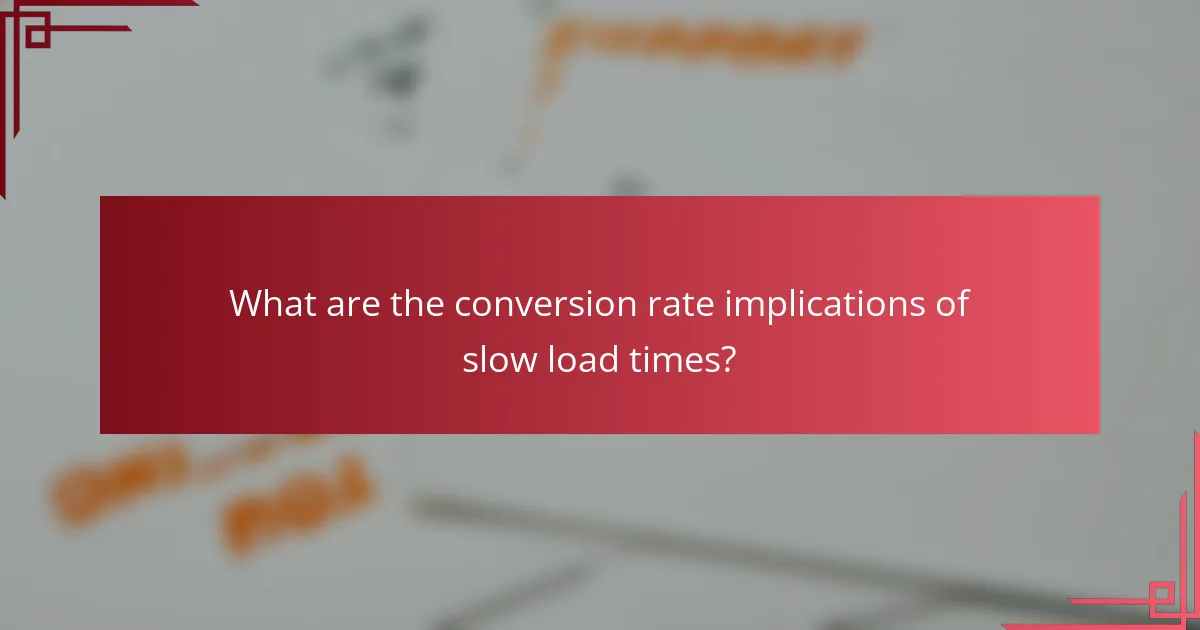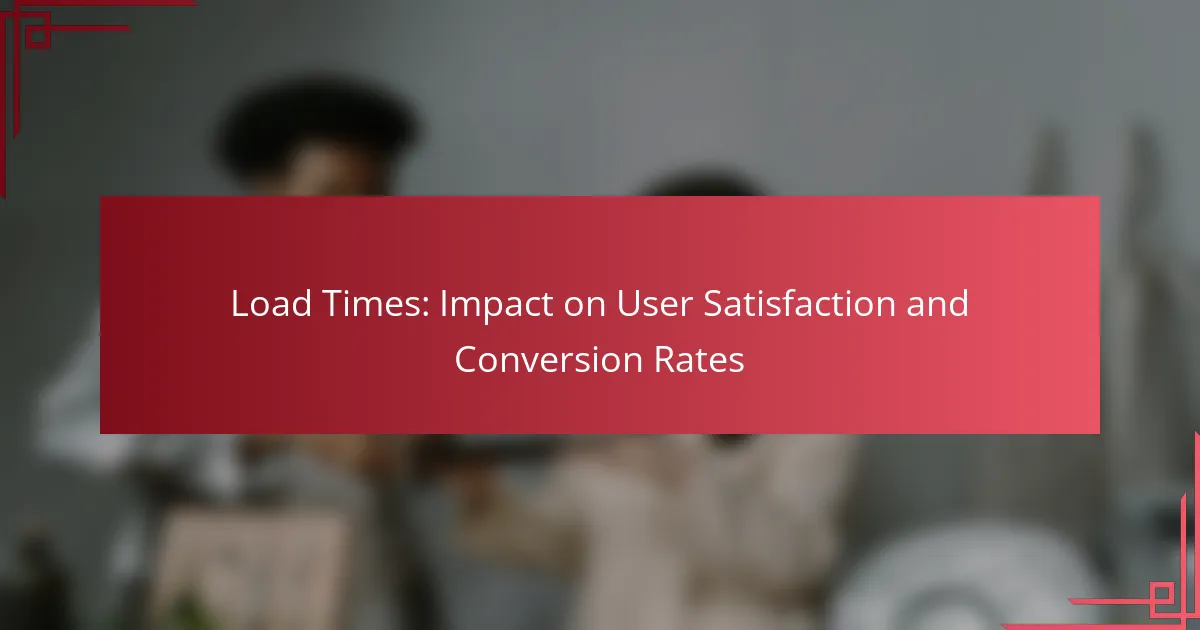In today’s digital landscape, load times play a crucial role in determining user satisfaction and conversion rates. Slow-loading websites can frustrate users, leading to increased abandonment and a negative overall experience. Even minor delays can significantly impact engagement and sales, making it essential for businesses to prioritize website performance through optimization strategies.

How do load times affect user satisfaction in the US?
Load times significantly impact user satisfaction in the US, as slower websites often lead to frustration and abandonment. Users expect fast-loading pages, and delays can result in a negative experience that drives them away from a site.
Direct correlation with bounce rates
There is a strong link between load times and bounce rates, with studies showing that even a one-second delay can increase bounce rates by a notable percentage. Users are less likely to wait for a page to load if it takes longer than a few seconds, often leaving the site before it fully appears.
To minimize bounce rates, aim for load times under three seconds. Regularly test your site’s performance and optimize images and scripts to ensure quick loading.
Impact on user engagement metrics
Faster load times enhance user engagement metrics, such as time spent on site and pages per session. When users encounter a speedy experience, they are more likely to explore additional content and interact with features.
Consider implementing strategies like lazy loading for images and prioritizing critical content to improve engagement. Monitoring metrics regularly can help identify areas needing improvement.
Influence on brand perception
Load times play a crucial role in shaping brand perception. A website that loads quickly conveys professionalism and reliability, while slow-loading sites can lead to negative associations with the brand.
To foster a positive brand image, ensure your website is optimized for speed. Regularly review performance and user feedback to make necessary adjustments that enhance both speed and user satisfaction.

What are the conversion rate implications of slow load times?
Slow load times can significantly hinder conversion rates by causing potential customers to abandon their shopping carts or lead forms. Research indicates that even a delay of a few seconds can lead to a noticeable drop in user satisfaction and engagement, ultimately affecting sales and leads.
Reduction in e-commerce sales
For e-commerce businesses, slow load times can directly correlate with reduced sales. Studies show that a delay of just one second can decrease conversions by around 7%. This means that if an online store takes too long to load, customers are likely to leave without making a purchase, leading to lost revenue.
To mitigate this, businesses should aim for load times under three seconds. Regularly testing website speed and optimizing images and scripts can help maintain this standard, ensuring a smoother shopping experience for users.
Effect on lead generation
Slow load times can severely impact lead generation efforts, particularly for businesses relying on forms or landing pages. If a potential lead encounters delays, they may abandon the page before submitting their information, resulting in fewer leads captured.
To improve lead generation, ensure that landing pages load quickly, ideally within two seconds. Utilizing tools like Google PageSpeed Insights can help identify areas for improvement, such as reducing server response times or minimizing JavaScript execution.
Impact on customer retention
Customer retention is closely tied to user experience, and slow load times can lead to frustration, prompting users to seek alternatives. If customers consistently experience delays, they may choose to shop with competitors who offer faster, more reliable service.
To enhance retention, prioritize website performance by regularly monitoring load times and addressing any issues promptly. Implementing a content delivery network (CDN) can also help speed up load times for users across different regions, improving overall satisfaction and loyalty.

What are effective strategies to improve load times?
Effective strategies to improve load times include optimizing images, utilizing content delivery networks (CDNs), and minifying CSS and JavaScript. Implementing these techniques can significantly enhance user experience and increase conversion rates.
Image optimization techniques
Image optimization involves reducing the file size of images without sacrificing quality. Techniques include using appropriate formats like JPEG for photographs and PNG for graphics, as well as compressing images using tools such as TinyPNG or ImageOptim.
Consider using responsive images that adjust to different screen sizes, which can further enhance load times. Aim for a balance between quality and file size, targeting sizes in the low hundreds of kilobytes for faster loading.
Utilizing content delivery networks (CDNs)
Content delivery networks (CDNs) distribute your website’s content across multiple servers worldwide, reducing the distance data must travel to reach users. This can lead to faster load times, especially for visitors located far from your main server.
When selecting a CDN, consider factors such as coverage, performance, and pricing. Popular options include Cloudflare and Amazon CloudFront, which can provide significant improvements in load times, often reducing them by 50% or more.
Minifying CSS and JavaScript
Minifying CSS and JavaScript involves removing unnecessary characters, such as whitespace and comments, from your code. This process reduces file sizes, leading to quicker downloads and improved load times.
Tools like UglifyJS for JavaScript and CSSNano for CSS can automate this process. Regularly review and minify your code to keep load times low, aiming for a total file size of under 100 KB for optimal performance.

How can businesses measure load times?
Businesses can measure load times using various tools and techniques that provide insights into website performance. These measurements help identify areas for improvement, ensuring a better user experience and potentially higher conversion rates.
Using Google PageSpeed Insights
Google PageSpeed Insights is a free tool that analyzes the content of a web page and generates suggestions to make that page faster. It provides a score from 0 to 100, with higher scores indicating better performance. Key metrics include loading time, interactivity, and visual stability.
To use PageSpeed Insights, simply enter the URL of your website, and the tool will evaluate it. Pay attention to the suggestions provided, such as optimizing images or leveraging browser caching, to enhance load times effectively.
Monitoring with GTmetrix
GTmetrix offers a detailed analysis of website performance, combining Google Lighthouse and Web Vitals metrics. It provides insights into load times, total page size, and the number of requests made by the page. Users can view historical data to track performance changes over time.
To get started with GTmetrix, enter your website URL and review the performance scores. The tool highlights specific areas for improvement, such as reducing server response time or minimizing JavaScript, which can significantly impact load times.
Implementing real user monitoring (RUM)
Real User Monitoring (RUM) involves collecting data from actual users as they interact with your website. This method provides insights into load times experienced in real-world conditions, accounting for various devices and network speeds. RUM helps identify performance bottlenecks that synthetic tests may overlook.
To implement RUM, use tools like Google Analytics or dedicated RUM services. Ensure you track key metrics such as First Contentful Paint (FCP) and Time to Interactive (TTI) to understand how users experience your site. Regularly analyze this data to make informed decisions on performance enhancements.

What are the best practices for mobile load times?
To enhance mobile load times, prioritize responsive design and implement mobile-specific optimization techniques. These practices ensure that websites load quickly and efficiently on various mobile devices, directly impacting user satisfaction and conversion rates.
Responsive design considerations
Responsive design is crucial for optimizing mobile load times. It allows a website to adapt its layout and content based on the screen size, ensuring a seamless experience across devices. Use flexible grid layouts and scalable images to maintain performance without sacrificing quality.
Additionally, consider the use of media queries to apply different styles for various devices. This approach minimizes unnecessary loading of resources that are not needed on smaller screens, improving overall speed. Aim for a design that prioritizes essential content to enhance user engagement.
Mobile-specific optimization techniques
Implementing mobile-specific optimization techniques can significantly reduce load times. Start by compressing images and using modern formats like WebP, which offers better quality at smaller file sizes. Minimize the use of heavy scripts and leverage asynchronous loading to ensure that critical content loads first.
Utilize caching strategies to store frequently accessed data, reducing the need for repeated downloads. Tools like Google PageSpeed Insights can help identify specific areas for improvement. Regularly test your site’s performance on various mobile devices to ensure optimal load times and user experience.
